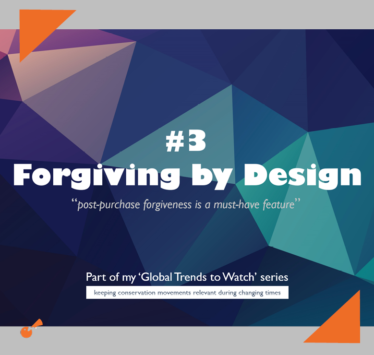
Global Trends to Watch: #3 Forgiving by Design
Global Trends to Watch: #3 Forgiving by Design
Empathy is a hot topic
It comes up often in articles about effective leadership styles. A search for “empathy” on Harvard Business Review returns 40 articles and case studies that have been published in 2018 alone. That’s, like, 6 articles a month on this topic!
Certainly, the topic surfaces often in conservation work. Both in terms of establishing greater empathy for animals and nature and having empathy when we’re asking others to change their behaviors.
It makes sense that this is a hot topic. Our desire to be deeply understood by others, and to understand others in return, is among the most innate of human needs. And this desire extends far beyond our immediate social circles.
We expect empathy from companies too
Increasingly, we as consumers, expect businesses, brands, services, products (and more!) to empathize with us as individuals.
And what does “empathize with us as individuals” mean?
Well, it starts with: “to err is human”.
Yup, we’re gonna make mistakes. Especially as we move too fast in a world too full of distractions.
Which means, “to forgive, divine”.
We’re entering a new chapter where we fully recognize that mistakes are inevitable, and we expect brands to be understanding and empathetic. And not penalize us for mistakes.
The ones leading this trend are taking it a step further by anticipating when consumers may need empathy the most. Bringing us to our third trend: FORGIVING BY DESIGN “post-purchase forgiveness is 2018’s must-have feature”
Forgiveness should feel magical
It’s important not to under-estimate this expectation as it can be sky high.
We’re not just talking about being the kind of organization that makes amends when mistakes have been made on your end. Or being flexible and “kind” when a consumer makes an honest mistake on their end.
This is a trend where consumers will demand nearly magical adaptability, turn-key agility, and proactive anticipation. For both mistakes made by them and for when outside, uncontrollable factors create a less-than-ideal experience.
Like when the home technology company Nest offered an energy-saving Solar Eclipse Rush Hour option for Nest Thermostat users, timed with the solar eclipse in August 2017.
Unbeknownst to most energy users, the lack of light during an eclipse impedes the production of solar power, which results in a ‘rush hour’ demand for energy from power plants. This can be avoided by turning home A/C’s down just a few degrees. But most home owners don’t realize that solar eclipses cause this chain reaction. And, therefore, they don’t take the necessary steps to reduce their contribution to the problem. Even if they would have liked to!
Nest sent a notification to customers’ connected thermostats, giving them the option to automatically cool their homes prior to the eclipse and conserve energy during the rush hour. Helping consumers play the energy-conserving roles they want to.
A fun example of forgiving by design is this Kit-Kat machine. It was placed in the São Paulo, Brazil airport solely to give out free Kit-Kats to anyone whose flight was delayed. Outside factors create these crappy moments, but Kit-Kat makes it a bit brighter with some free candy. Imagine if the airport itself did something like this!?! They’d be the best damn airport to be delayed in!
What does this mean for you?
The goal here is to anticipate when consumers may be expecting empathy and forgiveness. This requires understanding how your audiences behave and their user-experience with your services, products and offerings.
It won’t hurt to brainstorm all the areas where people tend to make mistakes, or circumstances that lead to less-than-ideal experiences, to pinpoint areas where you can proactively make things more seamless and painless. Past dealings with irate consumers can provide great insights here!
If you’re an environmental organization that accepts member-based donations on a recurring basis, you can offer a program where donations are lighter during higher spending months (like holidays) to prevent members from cutting off giving altogether. Maybe you can proactively offer to increase giving during a set month when a disaster hits or when funds are needed most.
If you host events or offer experiences as part of your engagement tactics, you can find creative ways to make potentially negative moments feel less painful. We know that people will forget umbrellas, sunscreen, water bottles, cash, checkbooks, and everything else! Can we anticipate those needs, demonstrate empathy and forgiveness, and serve up a smile instead? In the same way Kit-Kat did.
I covered this trend in more detail
during a free live webinar I held on June 27, 2018. Watch the replay below.
Don’t miss out on future webinars. Stay in the know by using the sign-up form down below.


